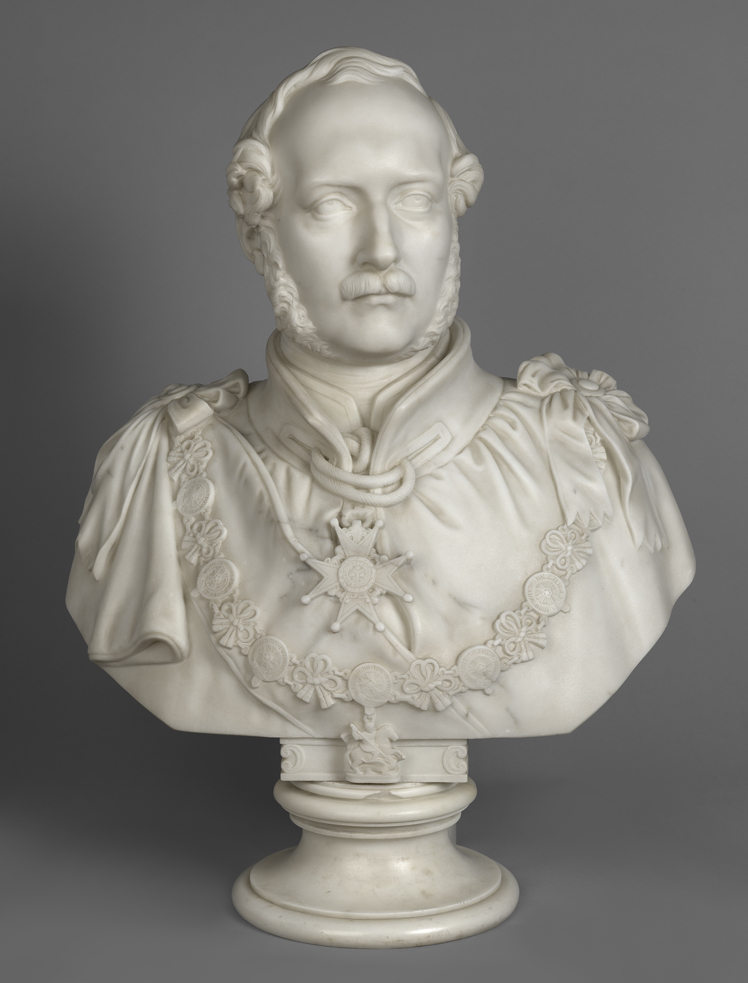

05:00PM, Monday 22 September 2025

Pictured: Bust of Prince Albert on display in St George’s Hall at Windsor Castle. Credit: © Royal Collection Enterprises Ltd 2025 | Royal Collection Trust
A sculpture of Prince Albert at Windsor Castle was made by his grieving daughter, according to ‘one of the largest’ catalogues being published by the Royal Collection tomorrow (Tuesday).
The bust of Queen Victoria’s husband, on display in the royal residence for over 160 years, was made by Princess Victoria in memory of her beloved father after his untimely death in 1861.
The discovery is among new revelations and research published for the first time in the four-volume catalogue, European Sculpture in the Collection of His Majesty the King.
The catalogue has been 30 years in the making, and its scope is ‘unprecedented’, covering all work in the Royal Collection by European sculptors across all materials, from the late 15th to the late 20th centuries.
Prince Albert and his eldest daughter, Princess Victoria, shared a love for the arts, including sculpture, with both known to give lengthy advice when commissioning new works.
Like her sisters, the Crown Princess took lessons in sculpting and created the posthumous bust with her tutor, Hugo Hagen, perhaps fearing someone else would not do her ‘dear Papa’ justice.
In a heartfelt letter to her mother, Queen Victoria, Princess Victoria wrote from Berlin: “It is a work which completely engrosses me … I feel very nervous … I hope you will like it.
“How I wish you were here to give advice.”
The Queen’s reply came days later: ‘I like it extremely,’ adding only that the nose was a touch too thick.
The Princess and her husband, the Crown Prince of Prussia, gifted the sculpture to Queen Victoria on Christmas 1864.

Pictured: Albert, Prince Consort, c.1862–4, modelled by Victoria, Crown Princess of Prussia and carved by Hugo Hagen. Photo credit: © Royal Collection Enterprises Ltd 2025 | Royal Collection Trust
The sculpture has been on prominent display at St George’s Hall for more than a century, but it was long believed to be the work of the sculptor Robert William Sievier.
During his research, catalogue author Jonathan Marsden determined that the bust could not be Sievier’s, which was known to depict Albert at age 23.
By examining archival correspondence between the Queen and her daughter, he identified the sculpture as the lost bust created by Princess Victoria to commemorate her father.
The former director of the Royal Collection hopes sharing the discoveries in the catalogue and online will give visitors a ‘renewed appreciation’ for the artworks.
Mr Marsden added: “Sculpture can easily fade into the background, yet closer examination can reveal works of art of quality and significance with their own stories to tell.”
Extensive research into the sculptures in the Collection has shed light on their varied uses through the centuries.
Queen Victoria had a particular fondness for using sculpture to preserve the memory of growing children or lost loved ones.
A bust of the young Prince Albert, by Emil Wolff, was gifted to Queen Victoria on their engagement in 1839, and kept next to her desk in her sitting room at Buckingham Palace for 60 years.
However, in recent times, its identity had been forgotten, and it was described as an ‘unknown man’.
Victoria also commissioned the sculptor Mary Thornycroft to portray her growing family, even hiring her as a sculpting tutor for her daughter, Princess Louise.
The first comprehensive catalogue of sculpture in the Royal Collection will be published on Tuesday, September 23, by Modern Art Press in association with Royal Collection Trust.
Mr Marsden said: “The publication of the catalogue raisonné marks the completion of one of the largest cataloguing projects undertaken by Royal Collection Trust, recording almost 2,000 works of art and bringing this part of the Royal Collection into the light.
“By sharing our discoveries, both through the catalogue and online, we hope visitors to the palaces will have a renewed appreciation of these beautiful works of art and pieces of history.
“For researchers and specialists, the catalogue represents an important new body of evidence, the foundation for future scholarship.”
Most read
Top Articles
It’s the ‘end of an era’ for Maidenhead Golf Club after members played a final round at their Shoppenhangers course before moving off.
Liverpool Football Club jerseys, red balloons and ribbons adorned streets across the town to commemorate Reuben Virdee, 11, who passed away earlier this month.
The Royal Borough has released a revised timetable for bin collections across Windsor and Maidenhead over the festive period.